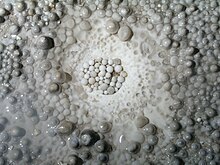Pisoid

Pisoid (lat. Pisum "pea") is a round single grain in sedimentary rocks , which is created by the deposition of thin mineral layers .
Demarcation
This term from petrography has different meanings in the older literature. A widespread meaning denotes a layered, relatively large lime grain (or non-lime grain) with a core that is not formed in the sea . Today it is understood to mean carbonate or non-carbonate grains, which are similar in their layer structure to the ooids . However, they differ from ooids in other formation mechanisms, other formation spaces, in the detailed structure and above all in their size (usually from a few millimeters to centimeters). Due to the ambiguity of the term, it is now common to designate the term “pisoid” more precisely using a suitable combination that includes the formation, such as cave episoids, calichepisoids and fluvial or lacustrine pisoids.
Some authors also use the term pisoid to describe round carbonate grains that are formed by algae. These pisoids should, however, correctly be called oncoids or rhodolites.
definition
Pisoids are usually round, structurally similar to the ooids with a diameter of more than 2 mm (up to several centimeters). They have dense, often somewhat irregular layers around a core ( nucleus ). The form is controlled by the place of education. Some pisoids in continuously moving water show increasing sphericity in the outer layers, e.g. B. Cave pisoids (" cave pearls ") in dripping water tubs or pisoids in hot springs. On the other hand, pisoids that were formed in weakly agitated water often show a decreasing sphericity in the outer layers. Other pisoids are asymmetrical and form thicker layers above and below; others are elongated to the side. More rarely, pisoids are also linked to one another. They can be broken and encrusted again. The cores are mostly litho clasts , peloids , fragments of other pisoids or cement crusts. Pisoids are formed almost purely chemically through precipitation (cave episoids, pisoids in thermal springs ), but also with the strong involvement of microbial mats (e.g. calichepisoids).
Rocks that mainly consist of pisoids are known as pisolites . German names for it are pea stone or hot spring stone , although these terms are limited to cave pisoids or pisoids in thermal springs.
Occurrence
The pisolith and pea stone deposits in Karlsbad were already described and discussed by Johann Wolfgang von Goethe in a paper. Other European deposits can be found in Lower Austria , Switzerland and France , among others .
Individual evidence
- ^ Hans Murawski, Wilhelm Meyer: Geological dictionary. 12th edition. Spektrum Akademischer Verlag, 2010, ISBN 978-3-8274-1810-4 , p. 125
- ^ Johannes Baier: Goethe and the thermal springs of Karlovy Vary (Karlsbad, Czech Republic) . Annual reports and communications of the Upper Rhine Geological Association, N. F. Vol. 94, 2012, pp. 87–103, doi: 10.1127 / jmogv / 94/2012/87 .
- ↑ Johannes Baier: Goethe's mineralogical studies in Bohemia. Geohistorische Blätter, Vol. 30, 2019, pp. 29–47.
literature
- Hans Füchtbauer and Detlev K. Richter: Carbonate rocks. In: Hans Füchtbauer (Ed.): Sediment-Petrology, Part 2, Sediments and Sedimentary Rocks. 4th ed., Pp. 233-434, E. Schweizerbart'sche Verlagsbuchhandlung, Stuttgart 1988, ISBN 3-510-65138-3 .
- Erik Flügel: Microfacies of Carbonate Rocks. Springer Verlag, Berlin, Heidelberg & New York 2004 ISBN 3-540-22016-X
Web links
- Pea stone (Pisolith) from the basalt quarry Wildon, Weitendorf (Styria)


